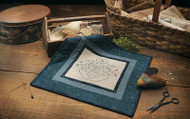Which Needles and Threads to Use?
Posted by Judy on May 18th 2017
I’ve never taken the time to learn about different needle and thread types, and which work best for different types of stitching. I asked several designers as well as my sisters Jeni and Gretchen for advice. Then, being the analyst I've always been, I created a handy chart that helps me see what’s what. I hope it helps you, too.
Needle and Thread Chart
| Purpose | Needle | Thread |
| Big-stitch quilting | #7 Embroidery or wool appliqué needle
Size 11 quilting needles |
12 Wt. perle cotton
Hand-quilting thread |
| Cotton appliqué
Needleturn appliqué |
Size 11 appliqué needle
Size 11 milliner |
100 Wt. silk
60 Wt. cotton |
| Embroidery | #7, #9, or #10 Embroidery needle
Wool appliqué needle #24 Chenille needle |
12 Wt. perle cotton
50 Wt. cotton Floss Embroidery floss, with 2 strands |
| Piecing by hand | Embroidery needle long enough to hold a lot of stitches
#9 is good length |
50 Wt. cotton |
| Piecing by machine | #80 Sewing machine needle | 50 Wt. cotton |
| Shirring, standing wool | Shirring needle 5-6” | Heavy-duty thread |
| Whipstitch edge of rug | Jumbo tapestry needle | Yarn |
| Wool, wool appliqué
(on cotton and on wool) |
#22, #24 Chenille needle
#7 - #9 Embroidery or wool appliqué needle Large-eye embroidery needle |
8 or 12 Wt. perle cotton
6-Strand floss, using 2 strands 2-Strand floss or wool thread Any thickness |

